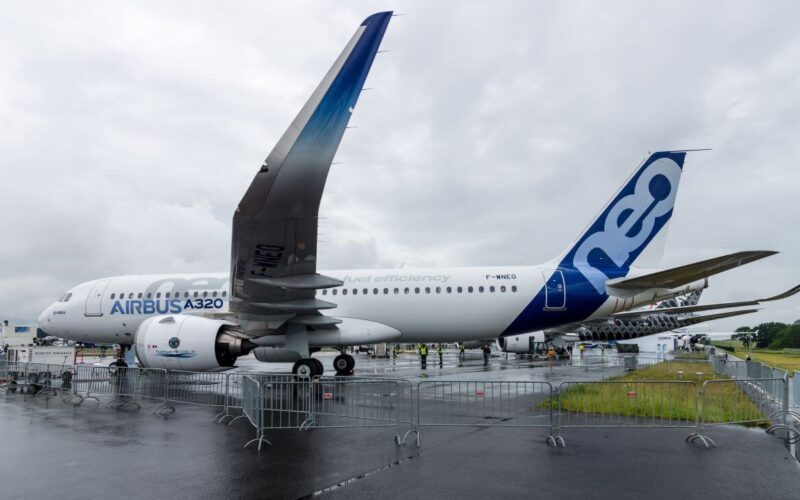Within less than a month, the European Union Aviation Safety Agency (EASA) has issued two airworthiness directives addressing issues detected in certain members of the Airbus A320 family – the A321neo and A320neo. The issues, although of different origins and appearing under specific conditions, relate to the aircraft’s angle of attack protection and could potentially lead to an excessive pitch scenario, the agency stated. Some aviation professionals have noted that the issue in both cases is similar to the one that the MCAS software on the Boeing 737 MAX was developed to address.
In July 2019, the EASA issued an Airworthiness Directive (EASA AD 2019-01-71) alerting operators of the A321neo of a weakness in the angle of attack (AoA) protection. The issue, identified during analysis of the behavior of the elevator and aileron computer, was described as having the potential to lead to excessive pitch attitude under “certain flight configurations and in combination with specific manoeuvres commanded by the flight crew”.
The agency ordered operators of the A321neo to revise their flight manuals according to temporary revisions (AFM TR) developed by Airbus. That particular directive, considered as an “interim action”, has since been revised and re-published on July 31, 2019 (EASA AD 2019-01-71R1), commanding operators of the aircraft type to comply with the manufacturer’s recommendations within a 30 day ‘window’ starting August 7, 2019.
On the same day, July 31, 2019, the authority released another directive (EASA AD 2019-01-89), addressing a similar issue with the A320neo, detected during “analysis and laboratory testing of the behaviour of the flight control laws” of the aircraft type.
Airbus clarifies pitch up scenario
A spokesperson for Airbus told AeroTime that this latest issue was identified during tests of a new in-development flight control computer on the A320neo. The manufacturer also confirmed that, as in the previous case, the problem affecting the A320neo results in reduced efficiency of the AoA protection when the aircraft is set in a “remote combination” of circumstances, as previously mentioned in the EASA AD.
Perhaps aiming to distance itself from the AoA problems on the Boeing 737 MAX, Airbus highlighted that there are “clear dissimilarities” between the issues affecting its A320neo/A321neo aircraft and “other scenarios currently being discussed, which are affecting aircraft other than Airbus aircraft types”. The manufacturer also stressed that despite the similarities between the A320neo and A321neo cases, “there are clear differences specific to the A320neo”.
The issue affecting the A320neo, as the plane maker explains, requires a combination of four conditions which are:
· aircraft at a significant Aft CG (Center of Gravity);
· sustained and continuous deceleration;
· aircraft in approach or landing configuration;
· the need for the crew to perform a dynamic pitch up manoeuver.
These “very remote combination of factors” result in a reduced efficiency of the AoA protection, which could lead to an angle of attack beyond the aircraft protection envelope (EP) and the possibility of the aircraft entering a pitch up situation.
Perhaps referencing to the anti-stall MCAS software installed on the Boeing 737 MAX, Airbus highlights that under these conditions the autopilot does not override the crew’s manual inputs. The flight crew have the capability to immediately react to a pitch up scenario on the A320neo, “allowing quick and immediate safe control of the situation,” it assures.
Similarly as with the A321neo, Airbus issued temporary revisions to the A320neo flight manual to address the potential dangers. In this case, however, the revisions were aimed at limiting the center of gravity envelope for the airplane (Aft CG). In addition, the manufacturer provided loading recommendations.
A spokesperson for Airbus told AeroTime that additional analysis proved it “necessary to implement an Aft CG limitation for the A320neo”, in addition to “the previous action” identified for the A321neo. According to the manufacturer, other members of the A320 family – A318, A319ceo, A320ceo, and A321ceo, as well as A321neo and A319neo variants – are not affected by this specific issue.
EASA jumps to action
“During the development of a future standard of the flight control computer, issues triggered by particular aircraft configuration and specific manoeuvre have prompted EASA to limit the Centre of Gravity (CG) envelop of the A321NEO,” the agency stated to AeroTime. “We have therefore issued an Airworthiness Directive in our Safety Publication tool to address this”.
Contrary to the case of the A321neo, this time, the EASA did not wait for further requirements and revision of its own AD and ordered operators of the A320neo to revise their flight manuals according to Airbus’ instructions within 30 days starting on August 14, 2019.
Airbus supports the EASA’s decision to issue the AD and is working with its customers to implement the directive. Both the agency and the manufacturer stressed that the issue never occurred during operations.
“No issue has ever occurred in-service, and the situation(s) that the EASA AD 2019-0171 actions [airworthiness directive issued for the A320neo, – ed. note] aim at preventing, is/are considered as rarely experienced during airline operations,” the authority said. “With this CG envelope limitation, the performance of the flight control computer works as originally intended, even in those particular aircraft configuration and specific manoeuvres.”

